INSTITUT SUPERIEUR D'ANTHROPOLOGIE
INSTITUTE OF ANTHROPOLOGY
ONLINE COURSES / COURS A DISTANCE
SPRING TERM : APRIL 2015
REGISTER NOW
CHINE – 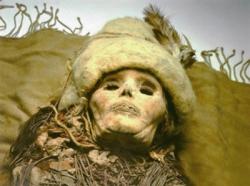 Xiaohe - A 3,500-year-old perforated female skull has been discovered at the Xiaohe tomb complex, which contained the largest number of mummies to have been found in the world, in northwest China's Xinjiang Uygur Autonomous Region. Zhu Hong, an archaeologist with Jilin University, told an annual archaeological meeting over the weekend that the hole in the skull was about six centimeters in diameter, and there was evidence of healing tissues near the wound. Scientists concluded that the modern practice of craniotomy, a surgical operation performed on the brain through an incision in the skull, may have been in use in China three centuries ago. "[The wound] suggests that the female, who died in her 40s, must have lived for at least a month, or even longer, after receiving the surgery," Zhu said. Last November, archaeologists identified China's oldest adhesive, in the form of gelatine, from a 3,500-year-old ritual staff in the same tomb. The Xiaohe cemetery, 175 km west of the ancient city of Loulan, was first explored by Folke Bergman, a Swedish archaeologist in 1934. The massive burial site has over 300 graves and is known for its ship-shaped coffins.
Xiaohe - A 3,500-year-old perforated female skull has been discovered at the Xiaohe tomb complex, which contained the largest number of mummies to have been found in the world, in northwest China's Xinjiang Uygur Autonomous Region. Zhu Hong, an archaeologist with Jilin University, told an annual archaeological meeting over the weekend that the hole in the skull was about six centimeters in diameter, and there was evidence of healing tissues near the wound. Scientists concluded that the modern practice of craniotomy, a surgical operation performed on the brain through an incision in the skull, may have been in use in China three centuries ago. "[The wound] suggests that the female, who died in her 40s, must have lived for at least a month, or even longer, after receiving the surgery," Zhu said. Last November, archaeologists identified China's oldest adhesive, in the form of gelatine, from a 3,500-year-old ritual staff in the same tomb. The Xiaohe cemetery, 175 km west of the ancient city of Loulan, was first explored by Folke Bergman, a Swedish archaeologist in 1934. The massive burial site has over 300 graves and is known for its ship-shaped coffins.
http://www.china.org.cn/china/2015-02/03/content_34724523.htm?
USA – 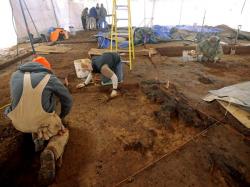 Chillicothe - Further excavation of a small American Indian mound continued at the Guernsey Crossing development Friday as archaeologists fight to keep the ground from freezing.Ohio Valley Archaeology Inc., Heartland Earthworks Conservancy, the Ohio History Center and the Cincinnati Museum Center sent volunteers to carefully move the mound, which is being dated between 200 B.C. and A.D. 200, Burks said."Before 2008, it was a bump around 2 1/2 feet tall and quite easy to see," Burks said. "It was known by many but, for some reason, wasn't reported. Many mounds go unreported. ... I was contacted by a number of people who said the developer was starting to dig, and we came to an agreement on excavation." Burks said mounds such as the one on North Bridge Street often contain human burials. Upon inspection, it appears the nearly 2,000-year-old mound could cover the foundation of a building with areas where posts were originally set vertically into the ground. Pottery fragments and burned bones belonging to humans and animals have been found. Burks and his colleagues conducted a magnetic survey of the site, which allows them to detect the original footprint of the mound and where to dig. Excavation could reveal spots within the original structure where cremations occurred and other items were burned, Burks said. "When the fire gets that hot, it burns the soil too," Burks said. "It's pretty easy to see that in the ground." There are no plans to look for other mounds in the area, Burks said, because it is not uncommon for mounds to be solitary.
Chillicothe - Further excavation of a small American Indian mound continued at the Guernsey Crossing development Friday as archaeologists fight to keep the ground from freezing.Ohio Valley Archaeology Inc., Heartland Earthworks Conservancy, the Ohio History Center and the Cincinnati Museum Center sent volunteers to carefully move the mound, which is being dated between 200 B.C. and A.D. 200, Burks said."Before 2008, it was a bump around 2 1/2 feet tall and quite easy to see," Burks said. "It was known by many but, for some reason, wasn't reported. Many mounds go unreported. ... I was contacted by a number of people who said the developer was starting to dig, and we came to an agreement on excavation." Burks said mounds such as the one on North Bridge Street often contain human burials. Upon inspection, it appears the nearly 2,000-year-old mound could cover the foundation of a building with areas where posts were originally set vertically into the ground. Pottery fragments and burned bones belonging to humans and animals have been found. Burks and his colleagues conducted a magnetic survey of the site, which allows them to detect the original footprint of the mound and where to dig. Excavation could reveal spots within the original structure where cremations occurred and other items were burned, Burks said. "When the fire gets that hot, it burns the soil too," Burks said. "It's pretty easy to see that in the ground." There are no plans to look for other mounds in the area, Burks said, because it is not uncommon for mounds to be solitary.
VIDEO = http://www.chillicothegazette.com/story/news/local/2015/01/30/excavation-small-bridge-street-mound-continues/22584745/
GRECE – 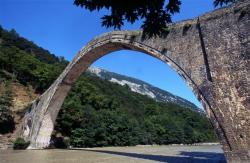
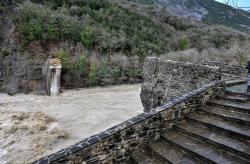 Plaka - The Ottoman-era bridge of Plaka, the widest stone bridge in the Balkans, has collapsed due to floods. Restoration of the bridge was on the agenda in 2007, but work was not begun. Standing on the border of the prefectures of Arta and Ioannina, the historic bridge had stood over the Arachthos River for 148 years. The link was constructed by Constantinos Bekas in 1866 after two unsuccessful attempts by other builders in 1860 and 1863. It was the widest stone bridge in Ipiros and the biggest single-arch bridge in the Balkans, with a 40-meter arch span and 21-meter height. During World War II, the bridge was bombed by the Germans near its center, but it withstood the bombing, while the damage was subsequently repaired. It was considered one of the most difficult, single-arch bridges to construct.
Plaka - The Ottoman-era bridge of Plaka, the widest stone bridge in the Balkans, has collapsed due to floods. Restoration of the bridge was on the agenda in 2007, but work was not begun. Standing on the border of the prefectures of Arta and Ioannina, the historic bridge had stood over the Arachthos River for 148 years. The link was constructed by Constantinos Bekas in 1866 after two unsuccessful attempts by other builders in 1860 and 1863. It was the widest stone bridge in Ipiros and the biggest single-arch bridge in the Balkans, with a 40-meter arch span and 21-meter height. During World War II, the bridge was bombed by the Germans near its center, but it withstood the bombing, while the damage was subsequently repaired. It was considered one of the most difficult, single-arch bridges to construct.
http://www.hurriyetdailynews.com/floods-bring-down-ottoman-bridge-in-balkans-.aspx?pageID=238&nID=77779&NewsCatID=375
INDE - Balirajgarh -Archaeological Survey of India (ASI) has stopped the excavation work being done at Balirajgarh (Raja Bali ka Garh) in Madhubani district midway. "The reason is best known to the ASI. No reason has been cited behind the abrupt stalling of the excavation work," said a senior ASI official. This year, the ASI HQ did not give permission to continue excavation work at Balirajgarh, which is about 260km from Patna. Over 400 antiquities, including terracotta human and animal figurines and sealings, were found during the excavation conducted at Balirajgarh in January, 2014, which lasted six months.
http://timesofindia.indiatimes.com/city/patna/ASI-stops-excavation-work-at-Balirajgarh/articleshow/46100866.cms
FRANCE – Vallée de l'Evre - Sous la conduite de trois archéologues spécialistes du néolithique, un secteur des Mauges en bordure de l'Evre a été prospecté en 2014. Beaucoup de silex ont été trouvés. Trois jeunes archéologues néolithiciennes, originaires des Pays de Loire et qui se sont connues durant leurs études à Paris, ont présenté ce week-end, à Beaupréau, les résultats de la prospection réalisée en 2014 sur 19 parcelles situées dans la vallée de l'Evre, entre Beaupréau et Saint-Pierre-Montlimart. Une prospection menée avec les bénévoles de deux associations locales: le Rable et le Grahl. Les résultats sont encourageants: 569 silex taillés et neuf tessons de céramique ont été collectés. En cours de datation, ces éléments pourraient provenir du néolithique. Le trio a annoncé la poursuite des recherches, sur une partie du site prospecté, mais plus en profondeur.
http://www.ouest-france.fr/prospection-archeologique-569-silex-tailles-en-vallee-de-levre-3156614
FRANCE – 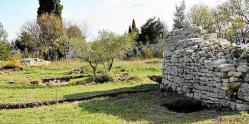 Vézénobres - Le site du plateau, situé non loin de la table d'orientation, où l'on perçoit des vestiges architecturaux, va peut-être livrer ses secrets. On y remarque un pan de mur orienté est-ouest qui présente une amorce de voûte. On peut s'interroger pour savoir quelles étaient les fonctions et la technique de construction de ce bâtiment. À quelle époque a-t-il été érigé ? Était-il isolé ou était-il intégré à d'autres vestiges qui n'ont pas encore été découverts ? Des recherches archivistes et notariales ont été menées, pour trouver la mention de structures architecturales, voire d'un fort, en ce lieu. Des indications sur des parcelles de propriétaires "confrontant la muraille du fort" et l'existence de "jardins et de ruines" apparaissent dans deux compoix des XVIe et XVIIe siècles.La municipalité de Vézénobres et le Groupe alésien de recherches archéologiques (Gara) ont donc décidé d'engager un sondage autorisé par le Service régional de l'archéologie (SRA). Depuis le mois d'octobre dernier, des tranchées de 1,50 m de large ont été ouvertes dans le prolongement du pan de mur et de son angle. Couche par couche, le terrain a livré quelques secrets. Sous des traces de démolition sont apparues des pierres en place dans la continuité du bâti hors sol. Il ne reste que le blocage interne du mur, les belles pierres de parement ayant été enlevées. Par qui ? Pourquoi ? Sur la façade Sud, quatre tessons de poteries pré ou protohistorique ont été récoltés, alors que les tranchées ont livré un éventail de tessons de céramiques datant du XIIIe au XIXe siècle. Un quatrième sondage a été engagé.
Vézénobres - Le site du plateau, situé non loin de la table d'orientation, où l'on perçoit des vestiges architecturaux, va peut-être livrer ses secrets. On y remarque un pan de mur orienté est-ouest qui présente une amorce de voûte. On peut s'interroger pour savoir quelles étaient les fonctions et la technique de construction de ce bâtiment. À quelle époque a-t-il été érigé ? Était-il isolé ou était-il intégré à d'autres vestiges qui n'ont pas encore été découverts ? Des recherches archivistes et notariales ont été menées, pour trouver la mention de structures architecturales, voire d'un fort, en ce lieu. Des indications sur des parcelles de propriétaires "confrontant la muraille du fort" et l'existence de "jardins et de ruines" apparaissent dans deux compoix des XVIe et XVIIe siècles.La municipalité de Vézénobres et le Groupe alésien de recherches archéologiques (Gara) ont donc décidé d'engager un sondage autorisé par le Service régional de l'archéologie (SRA). Depuis le mois d'octobre dernier, des tranchées de 1,50 m de large ont été ouvertes dans le prolongement du pan de mur et de son angle. Couche par couche, le terrain a livré quelques secrets. Sous des traces de démolition sont apparues des pierres en place dans la continuité du bâti hors sol. Il ne reste que le blocage interne du mur, les belles pierres de parement ayant été enlevées. Par qui ? Pourquoi ? Sur la façade Sud, quatre tessons de poteries pré ou protohistorique ont été récoltés, alors que les tranchées ont livré un éventail de tessons de céramiques datant du XIIIe au XIXe siècle. Un quatrième sondage a été engagé.
http://www.midilibre.fr/2015/01/29/archeologie-un-fort-dominait-il-la-cite-medievale,1117903.php
INDONESIE – 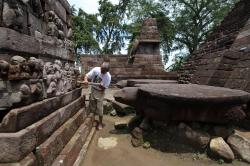 Ngargoyoso - The Central Java Heritage Conservation Agency plans to restore the Hindu temple, known as Sukuh, this March as the earth beneath the temple’s foundation continues to shift. Some parts of the exotic temple complex will remain open to tourists during the renovations, but not the main pyramid-shaped structure.Before work can start, however, the agency and a team of archeologists will remove some stones from the pyramid to study the best method to stop the main temple from further damage. The pyramid is now bulging on one side and could threaten the integrity of the entire structure. The pyramid’s structure is fragile as it is composed of rudimentary carved rocks held together with soil and clay, which is different from the Borobudur and Prambanan temples, which are made entirely out of stone. Sukuh temple is located in Ngargoyoso on the slopes of Mount Lawu, around 1,186 meters above sea level. It was built at the end of the Majapahit Kingdom in the 15th century and “rediscovered” in the 19th century by British voyager Thomas Raffles. The temple’s architecture is unusual as its main building resembles pyramids of Egypt and Mesoamerican civilizations.
Ngargoyoso - The Central Java Heritage Conservation Agency plans to restore the Hindu temple, known as Sukuh, this March as the earth beneath the temple’s foundation continues to shift. Some parts of the exotic temple complex will remain open to tourists during the renovations, but not the main pyramid-shaped structure.Before work can start, however, the agency and a team of archeologists will remove some stones from the pyramid to study the best method to stop the main temple from further damage. The pyramid is now bulging on one side and could threaten the integrity of the entire structure. The pyramid’s structure is fragile as it is composed of rudimentary carved rocks held together with soil and clay, which is different from the Borobudur and Prambanan temples, which are made entirely out of stone. Sukuh temple is located in Ngargoyoso on the slopes of Mount Lawu, around 1,186 meters above sea level. It was built at the end of the Majapahit Kingdom in the 15th century and “rediscovered” in the 19th century by British voyager Thomas Raffles. The temple’s architecture is unusual as its main building resembles pyramids of Egypt and Mesoamerican civilizations.
http://thejakartaglobe.beritasatu.com/news/collapsing-pyramid-hindu-temple-sukuh-restored-2016/